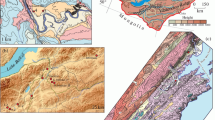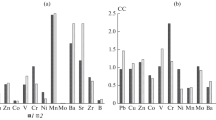Abstract
Purpose
Complex phenomena of the precipitation and accumulation of calcium carbonate in urban soils and sediments have been studied. They are linked to the interactions between the lithosphere, the biosphere, and the atmosphere. Calcium and its compounds are among the main elements determining soil’s morphological, physical, and chemical characteristics. This study was aimed at summarizing information about calcium carbonate concentrations in soils and finding evidence for the formation of carbonate micronodules by pedogenetic processes in Urbic Technosols under automorphic conditions.
Materials and methods
Moscow is located within the southern taiga belt, with a humid temperate climate and a percolative water regime. The city’s technogenic deposits contain significant amounts of carbonates due to inclusions of construction waste and additions of airborne dust. Contemporary humus-accumulative horizons of Urbic Technosols were found to contain carbonate accumulations (rounded or isomorphic nodules). Samples from such horizons were studied using a polarizing microscope (analysis of thin sections) and a scanning electron microscope with an energy-dispersive X-ray analyzer (element mapping to detect carbonate accumulations). Laboratory analyses of main chemical and physical soil properties were performed.
Results and discussion
The analyzed samples contained both primary (i.e., inherited from parent materials) and secondary (i.e., newly formed in soils) calcium carbonates in various forms. Inclusions of solidified mortar (carbonate building solutions) contained dolomite. Although the studied carbonates underwent recrystallization processes, they remained in soils for a long time. Fibrous Mg silicate films deposited at the surface of recrystallization areas were observed. The formation of carbonate micronodules at depths of 15–40 cm in slightly and moderately calcareous humus horizons was investigated. Newly formed calcite was distinguished by a homogeneous composition, a microsparitic size of crystals, and a compact packing within the groundmass. Newly formed calcite was observed within microzones that were free from carbonate inclusions with dissolution features.
Conclusions
The dissolution of primary carbonates in soils under humid climate conditions triggers pedogenetic processes of the carbonate heritage redistribution and the mineral matrix transformation. Recrystallized carbonates are the main forms of secondary carbonate accumulations in automorphic Technosols. The presence of compact carbonate nodules composed of microsparitic calcite within the bulk of silicate material may be indicative of carbonate neoformation as a result of interactions between the dissolved CO2 from root respiration and the soil absorbing complex saturated by Ca from soil solution. This is confirmed by a number of studies on the carbonate isotopic composition in urban soils.






Similar content being viewed by others
References
Adderley WP, Wilson CA, Simpson IA, Davidson DA (2014) Anthropogenic features. In: Stoops G, Marcelino V, Mees F (eds) Interpretation of micromorphological features of soils and Regoliths. Elsevier, Amsterdam, pp 569–588
Alexandrovskaya EI, Aleksandrovskiy AL (2000) History of the cultural layer in Moscow and accumulation of anthropogenic substances in it. Catena 41(1–3):249–259
Alexandrovskiy AL (2007) Pyrogenic origin of carbonates: evidence from pedoarchaeological investigations. Eur Soil Sci 5:471–477
Alexandrovsky AL, Boitsov IA, Krenke NA et.al. (1998) Excavations in the courtyard of the Moscow University: experience of an integrated approach to the study of the urban cultural layer. Natural-scientific methods in field archaeology Moscow: Institute of archaeology of the Russian Academy of Sciences 2:3–13 (in Russian)
Davidson DA, Dercon G, Stewart M, Watson F (2006) The legacy of past urban waste disposal on local soils. J Arhaeol Sci 33(6):778–783
Dobrovol’skii VV (2001) Soil carbonation, finely dispersed soil material, and geochemistry of heavy metals. Eur Soil Sci 34(12):1276–1253
Durand N, Monger HC, Canti MG (2014) Calcium Carbonate Features. In: Stoops G, Marcelino V, Mees F (eds) Interpretation of micromorphological features of soils and Regoliths. Elsevier, Amsterdam, pp 149–194
Greinert A, Kostecki J (2019) Anthropogenic materials as bedrock of Urban Technosols. In: Vasenev V, Dovletyarova E, Cheng ZH, Prokof’eva T, Morel J-L, Ananyeva N (eds) Urbanization: challenge and opportunity for soil functions and ecosystem services proceedings of the 9th SUITMA congress. Springer international publishing AG, part of springer nature
Guidelines for Soil Description (2006) Food and Agriculture Organization of the United Nations, Rome
Howard JL, Orlicki KM (2016) Composition, micromorphology and distribution of microartifacts in anthropogenic soils, Detroit, Michigan, USA. Catena 138:103–116
Hulisz P, Charzyński P, Greinert A (2018) Urban soil resources of medium-sized cities in Poland: a comparative case study of Toruń and Zielona Góra. J Soils Sediments 18:358–372
Itkin D, Goldfus H, Monger HC (2016) Human induced calcretisation in anthropogenic soils and sediments: field observations and micromorphology in a Mediterranean climatic zone, Israel. Catena 146(11):48–61
IUSS Working group WRB (2015) World Reference Base for soil resources 2014, update 2015. International soil classification system for naming soils and creating legends for soil maps. World soil resources reports no. 106. FAO, Rome
Kazdym AA (2006) Technogenic deposits of ancient and modern urbanized territories. Nauka, Moscow (in Russian)
Konstantinov AO, Novoselov AA, Loiko SV (2018) Special features of soil development within overgrowing fly ash deposit sites of the solid fuel power plant. Tomsk State Univ J Biol 43:6–24 (In Russian, English Summary)
Kovda IV (2008) Information value of carbonate neoformations for reconstruction of processes and factors of soil formation. In: Targulian VO, Goriachkin SV (eds) Memory of soils. LKI, Moscow, pp 352–397 (in Russian)
Kovda I, Mermut AR (2014) Vertic Features. In: Stoops G, Marcelino V, Mees F (eds) Interpretation of micromorphological features of soils and Regoliths. Elsevier, Amsterdam, pp 109–127
Lehmann A, Stahr K (2007) Nature and significance of anthropogenic urban soils. J Soils Sediments 7(4):247–260
Lokoshchenko MA, Korneva IA (2015) Underground urban heat island below Moscow city. Urban Clim 13:1–13
Lorenz K, Lal R (2015) Managing soil carbon stocks to enhance the resilience of urban ecosystems. Carbon Manag 6(1–2):35–50
Macphail RI, Goldberg P (2014) Archaeological materials. In: Stoops G, Marcelino V, Mees F (eds) Interpretation of micromorphological features of soils and regoliths. Elsevier, Amsterdam, pp 589–621
Manning DAC, Renforth P, Lopez-Capela E, Robertson S, Ghazirehd N (2013) Carbonate precipitation in artificial soils produced from basaltic quarry fines and composts: an opportunity for passive carbon sequestration. Int J Greenh Gas Con 17:309–317
Mees F (2014) Authigenic silicate minerals –sepiolite-palygorskite, zeolites and sodium silicates. In: Stoops G, Marcelino V, Mees F (eds) Interpretation of micromorphological features of soils and regoliths. Elsevier, Amsterdam, pp 497–520
Prokof'eva TV (2016) Horizons of urban soil: composition, processes and diagnostic features at the micro level. In: materials of the conference "SOIL MORPHOLOGY: from macro to submicro level. Moscow, December 19-21, 2016," V. V. Dokuchaev soil institute, Moscow, pp 333-336 (in Russian)
Prokof’eva TV, Kiryushin AV, Shishkov VA, Ivannikov FA (2017) The importance of dust material in urban soil formation: the experience on study of two young Technosols on dust depositions. J. Soils Sediments 2:515–524
Prokofyeva TV, Martynenko IA, Ivannikov FA (2011) Classification of Moscow soils and parent materials and its possible inclusion in the classification system of Russian soils. Eurasian Soil Sci 44(5):561–571
Prokof’eva TV, Sedov SN, Stroganova MN, Kazdym AA (2001) An experience of the micromorphological diagnostics of urban soils. Eur Soil Sci 34(7):783–792
Prokof’eva TV, Shishkov VA, Kiryushin AV, Kalushin IY (2015) Properties of solid (dust-aerosol) atmospheric depositions on near-road territories of Moscow. Izv Akad Nauk SSSR Ser Geogr 3:107–120 (in Russian with English abstract)
Prokof’eva TV, Varava OA, Sedov SN, Kuznetsova AM (2010) Morphological diagnostics of pedogenesis on the anthropogenically transformed floodplains in Moscow. Eur Soil Sci 43(4):368–379
Renforth P, Manning DAC, Lopez-Capel E (2009) Carbonate precipitation in artificial soils as a sink for atmospheric carbon dioxide. Appl Geochem 24:1757–1764
Revich BA (ed) (2006) Climate, quality of atmospheric air, and health of Moscow population. Institute of Economic Forecasting Russian Academy of Sciences, Moscow (in Russian)
Stroganova M, Miagkova A, Prokofieva T, Skvortsova I (1998) Soils of Moscow and Urban Environment. PAIMS, Moscow
Tselischeva L, Stroganova M (1996) Micromorphological diagnostics of urban soils. In I Abst. 10-th inter, working meeting of soil micromorphology. Moscow
Vorob’eva LA (ed) (2006) Theory and practice of the chemical analysis of soils. GEOS, Moscow (in Russian)
Washbourne C-L, Renforth P, Manning DAC (2012) Investigating carbonate formation in urban soils as a method for capture and storage of atmospheric carbon. Sci Total Environ 431:166–175
Zamanian K, Pustovoytov K, Kuzyakov Y (2016) Pedogenic carbonates: forms and formation processes. Earth-Sci Rev 157:1–17
Funding
The work was carried out with support from the following source: the Russian Foundation for Basic Research, with grant nos. 15-04-04702 and 9-04-01298 (field work and collection of samples, determination of soil properties, and their interpretation), and State Task 0148-2019-0006 (development of approaches to the definition and study of carbonate inclusions and neoformations in soils in microscopic studies).
Author information
Authors and Affiliations
Corresponding author
Additional information
Responsible editor: Kye-Hoon John Kim
Publisher’s note
Springer Nature remains neutral with regard to jurisdictional claims in published maps and institutional affiliations.
Rights and permissions
About this article
Cite this article
Prokof’eva, T., Shishkov, V. & Kiriushin, A. Calcium carbonate accumulations in Technosols of Moscow city. J Soils Sediments 21, 2049–2058 (2021). https://doi.org/10.1007/s11368-020-02696-y
Received:
Accepted:
Published:
Issue Date:
DOI: https://doi.org/10.1007/s11368-020-02696-y




